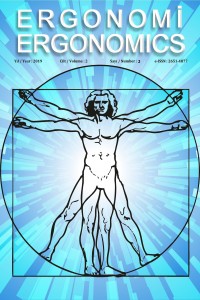INVESTIGATION OF THE EFFECT OF DIFFERENT TEXTILE PRODUCTS ON MUSCLE AND SKELETON SYSTEM BY USING THE IMAGING METHOD
Öz
Kaynakça
- Burgess-Limerick, R., Abernethy, B., 1997a. Qualitatively different modes of lifting. International Journal of Industrial Ergonomics 19, 413–417. Burgess-Limerick, R., Abernethy, B., 1997b. Toward a quantitative definition. Burgess-Limerick,R. 2003. Squat, stoop, or something in between? International Journal of Industrial Ergonomics: 31, 143–148. Chaffin, D.B, Andersson. G.B, 1991, Occupational Biomechanics, (2nd edition.), Wiley, New York Derafshi, M., Petrova, A., Jayadas, A., Peksoz, S., (2018). Musculoskeletal disorders associated with duty gear: Perceptions of campus law enforcement. Police Quarterly.Howe, J. M. (1997). Interfaces in materials. ISBN-10: 9780471138303Mah, C.D., Hulliger, M., Lee, R.G., O’Callaghan, I., (1994). Quantitative analysis of human movement synergies: constructive pattern analysis for gait. Journal of Motor Behavior 26, 83–102.Straker L, Mekhora K. (2000). An evaluation of visual display unit placement by electromyography, posture, discomfort and preference. International Journal of Industrial Ergonomics., 26, pp. 389-398Robertson, M., Amick, B. C., DeRango, K., Rooney, T., Bazzani, L., Harrist, R. ve Moore, A. (2009). The Effects of an Office Ergonomics Training and Chair İntervention on Worker Knowledge, Behavior and Musculoskeletal Risk. Applied Ergonomics: 40 (1), 124-135Rosenbaum, D.A., Meulenbroek, R.G.M., Vaughan, J., Jansen, C., 2001. Posture-based motion planning: applications to grasping. Psychological Review 108, 709–734.Werden, J. E., Fahnestock, M. K., & Galbraith, R. L. (1959). Thermal Comfort of Clothing of Varying Fiber Content. Textile Research Journal, 29(8), 640–651. https://doi.org/10.1177/004051755902900805Zhang, X., Nussbaum, M.A., Chaffin, D.B., 2000. Back lift versus leg lift: an index and visualization of dynamic lifting strategies. Journal of Biomechanics 33, 777–782.
OFİS İÇİ ÇALIŞMALARDA FARKLI TEKSTİL ÜRÜNLERİNİN KAS VE İSKELET SİSTEMİNE ETKİSİNİN GÖRÜNTÜLEME YÖNTEMİ KULLANILARAK ARAŞTIRILMASI
Öz
Günümüzde yaşanan teknolojik
yenilikler, statik ve dinamik postür için kas ve iskelet sisteminde
zorlanmalara sebep olmaktadır. Ofis çalışanların hayat kalitesinin
yükseltilmesi için pek çok çalışma yapılmıştır. Bu çalışmada oturma,
bilgisayarın kullanımı, elle yazı yazma, cep telefonu ile ilgilenme, dinlenme
gibi günlük hayatta karşılaşılan fonksiyonların referans noktaları kullanılarak
çöp adam şeklinin oluşturulması ile iskelet sisteminde oluşan farklı açı
değerleri incelenmiştir. Açılar BTS BioEngineering Motion Capture Technology
yazılımı kullanılarak hesaplanmıştır. Çalışma kapsamında 30 kişilik grup
içinden 4 çalışan seçilmiş ve çalışanların boyun, omuz, dirsek, sırt, diz ve
ayak bileklerinin yapmış olduğu açılar incelenmiştir. Çalışma Oklahoma State
Üniversitesinde İç Mekan Tasarımı ve Tekstil bölümünde yer alan Mix Reality
Laboratuvarında yapılmıştır. Çalışma için Oklahoma State Üniversitesinden etik
kurul izini alınmıştır. Çalışma sonucunda, bilgisayar kullanımı esnasında ve
cep telefonu kullanımı esnasında ofis çalışanlarının postürlerinde bozulma
olduğu görülmüştür, özellikle ense, omuz ve dirsek kısmında kas ve iskelet
sisteminde zorlamalar olduğu görülmüştür. Bozuk postürlerden dolayı, kas ve
iskelet sisteminde oluşan gerilmelerin
azaltılması için çeşitli önleyici tedbirler önerilmiştir.
Anahtar Kelimeler
Kaynakça
- Burgess-Limerick, R., Abernethy, B., 1997a. Qualitatively different modes of lifting. International Journal of Industrial Ergonomics 19, 413–417. Burgess-Limerick, R., Abernethy, B., 1997b. Toward a quantitative definition. Burgess-Limerick,R. 2003. Squat, stoop, or something in between? International Journal of Industrial Ergonomics: 31, 143–148. Chaffin, D.B, Andersson. G.B, 1991, Occupational Biomechanics, (2nd edition.), Wiley, New York Derafshi, M., Petrova, A., Jayadas, A., Peksoz, S., (2018). Musculoskeletal disorders associated with duty gear: Perceptions of campus law enforcement. Police Quarterly.Howe, J. M. (1997). Interfaces in materials. ISBN-10: 9780471138303Mah, C.D., Hulliger, M., Lee, R.G., O’Callaghan, I., (1994). Quantitative analysis of human movement synergies: constructive pattern analysis for gait. Journal of Motor Behavior 26, 83–102.Straker L, Mekhora K. (2000). An evaluation of visual display unit placement by electromyography, posture, discomfort and preference. International Journal of Industrial Ergonomics., 26, pp. 389-398Robertson, M., Amick, B. C., DeRango, K., Rooney, T., Bazzani, L., Harrist, R. ve Moore, A. (2009). The Effects of an Office Ergonomics Training and Chair İntervention on Worker Knowledge, Behavior and Musculoskeletal Risk. Applied Ergonomics: 40 (1), 124-135Rosenbaum, D.A., Meulenbroek, R.G.M., Vaughan, J., Jansen, C., 2001. Posture-based motion planning: applications to grasping. Psychological Review 108, 709–734.Werden, J. E., Fahnestock, M. K., & Galbraith, R. L. (1959). Thermal Comfort of Clothing of Varying Fiber Content. Textile Research Journal, 29(8), 640–651. https://doi.org/10.1177/004051755902900805Zhang, X., Nussbaum, M.A., Chaffin, D.B., 2000. Back lift versus leg lift: an index and visualization of dynamic lifting strategies. Journal of Biomechanics 33, 777–782.
Ayrıntılar
| Birincil Dil | Türkçe |
|---|---|
| Bölüm | Araştırma Makaleleri / Research Articles |
| Yazarlar | |
| Yayımlanma Tarihi | 1 Ağustos 2019 |
| Gönderilme Tarihi | 11 Kasım 2018 |
| Yayımlandığı Sayı | Yıl 2019 Cilt: 2 Sayı: 2 |
Dergi yılda 3 sayı (Nisan, Ağustos ve Aralık) olarak yayımlanmaktadır. Bu sayılara ek olarak Editörler Kurulu’nun kararıyla, Ulusal Ergonomi Kongresi’nde sunulan bildiriler “Özel Sayı” olarak yayımlanabilmektedir.


